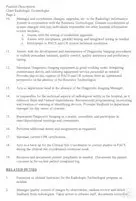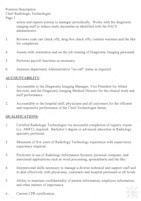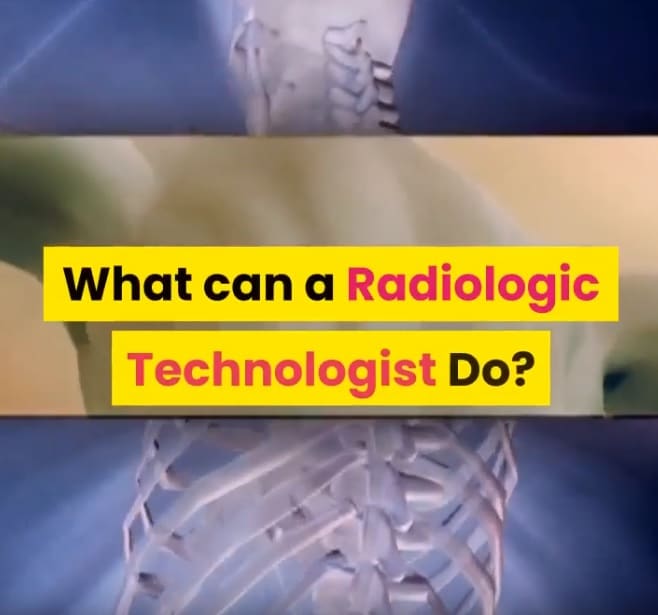During your last visit to the hospital for an x-ray, you might have met a Radiologic Technologist after that bad freak accident at home but were unaware of the fact. You might remember the huge X-ray machines placed over your injured arm or leg and being told to be still for a few seconds to ensure your X-ray comes out clear. Staying still the first time ensures that you don’t have to get it done a second time unless your doctor asks for a follow one a few weeks later.
After your examination, you get up and need care from some people in the room to ensure you don’t get hurt. Yep, that was a Radiologic Technologist. So what are they really, and what is the extent of their work?
What is a Radiologic Technologist?
- They are a major part of the family of healthcare specialists and professionals trained to perform diagnostic imaging procedures. Radiologic Technologist is a broad term for an employee licensed and trained in diagnostic imaging.
- The following can be considered “rad techs,” although they are more commonly referred to by their specific specialty:
- X-ray Techs
- CT or Computed Tomography Techs
- MRI Techs
- Ultrasound Techs
- Nuclear Medicine Techs
- PET or Positron Emission Tomography Techs
- Mammography Techs
- DEXA scan Techs
- IR or Interventional Radiology Techs
Most of these careers start with training in general X-ray or radiography. Through on-the-job training or returning to school, they move up the career ladder into “advanced modalities.” Everything outside of general X-rays is an advanced modality.
Radiologic technologists can also work with animals in a veterinary healthcare setting. Although not as common, some rad techs get to perform imaging on domestic animals like family pets and zoo animals. This requires additional training outside of radiology, such as veterinary assistant training. Some industrial radiographers image pieces of equipment to test for quality and durability.
Their jobs go beyond handling…
Their jobs go beyond handling the machines to the care of patients. They make sure that the body parts of patients that need to be imaged are handled with proper care for the patient’s benefit and also to ensure that that imaging is both accurate and of diagnostic quality. The work of Radiologic Technologists brings them to work closely with Radiologists. Radiologists are trained doctors with 16 years of schooling and clinical rotations or residencies.
Radiologists are part of the imaging team who take the medical radiologic images from technologists and interpret them to worried patients and family members. These radiologist interpretations are documented as imaging reports in the patient record. These reports are then shared with the patient’s physician, who ordered the examination in the first place.
But for the images to be interpreted by the Radiologist, the radiologic technologist has to ensure that the job is done well, i.e., ensure the images are clear and on-point in terms of scanning the body area that needs imaging to be diagnosed.
What are Rad Techs Educational Qualifications?
The academic qualification of a radiologic technologist is expansive:
- They need to know when it comes to the details and structure of the human body,
- They need to understand how to position the human body for optimum imaging.
- They need knowledge of radiographic exposure techniques for patients and themselves to avoid possible overexposure.
- They need a complete understanding of proper patient care and ergonomics for moving and lifting patients.
On the physical aspect of the job, a radiologic technologist needs to have good physical stamina, strong muscles, and good overall health. They have to remain standing for long periods at a time, have to be prepared to lift and carry disabled patients to the radiographic machines, as well as move the radiologic equipment from time to time. In addition, they may be required to work more than the standard 40 hour-work-week and be on-call when not at work.
With the looming influx of retiring baby boomers, it is estimated that the Department of Radiology will have to expand to a great degree to ensure it will handle the increased patient volume. This bodes well for rad techs worried about job security. There are clear signs that more techs than ever before will be needed to keep up with the fast-growing pace of patients needing healthcare.
Can a Radiologic Technologist administer medication?
- Yes, but to a limited degree. Mostly only contrast agents and saline.
- Some technologists can administer radioactive agents like in nuclear medicine.
Radiologic technologists work with the doctors for your treatment plan. Their main duty is to ensure that the image of an injury or a diseased area is clear enough for your radiologist or doctor to read your images and see what kind of treatment you require. They do have professional training to make sure they do their jobs well. But the training is not necessarily the same as medical or nursing school.
Rad tech training shares the patient care information but with less emphasis on pharmacology (medicines) and treatment plans. Rad techs FIND the problem. Doctors decide how to TREAT the problem. Nurses carry out the treatment plan with the patient.
There are a few medicines rad techs can administer. These medicines are called contrast. Contrast is a type of liquid dye that makes the blood vessels or internal organs appear on the images acquired. Contrast can be given orally, like a drink, or injected into the veins. Some rad techs, like nuclear medicine techs, inject radioactive contract media. These isotopes are administered to test an organ’s functionality or how well it is working. Mostly, radiologic technologists leave medicine dispensing to the nurses and doctors.
Can a Radiologic Technologist do Ultrasounds?
- Yes, they can but it will require additional on-the-job training or going back to school.
- Typical ultrasound programs take two years to complete and include classroom and clinical rotations.
Most ultrasound technologists, or Sonographers, start out in general x-ray but not all. There are some ultrasound schools that do not require an x-ray license for admission. Although the school I attended for ultrasound (Gateway Community College in Phoenix, AZ) did require licensure for admission. Each school has different guidelines so check with the one you might be interested in.
Either way, if you are interested in becoming a sonographer, you will need about two years of training. Ultrasound scanning is unlike any other imaging profession. It does not use x-rays or magnetic fields. It used ultrasound waves much like a submarine scans the waters around it or a fish finder on a boat searching in the waters below for fish.
Because of this unique imaging technique, a student would need to undergo lots of training in how to properly use the technology and identify structures. Radiologists depend on sonographers to know what they are looking at when performing their diagnostic imaging exams. Where an X-ray exam or CT scan captures an entire section of the body being imaged, ultrasound scanning only takes images of exactly where the ultrasound probe is pointing. If you don’t know what you are looking for, you won’t be able to capture the right images.
Can a Rad Tech take Verbal Orders?
- yes but it depends on local hospital policy.
In most cases, what happens is that your doctor gives a written order of what you need: CT, MRI, Ultrasound, X-Ray, etc. This order is given to the radiology department and assessed for accuracy. Once accurate, the written order is put into a computer system (called transcribed) and shows up on the technologist’s worklist. From there the technologist completes the exam and the order is complete.
However, there are times when a patient needs an exam and there is no written order. An emergency room patient, for example, may need a life-saving exam that can’t wait for paperwork. In these cases, the images are obtained out of medical necessity and the paperwork is figured out later. This is an example of a radiologic technologist acting on a verbal order from the emergency room physician.
Can a Radiologic Technologist Become a Radiologist?
- Yes and I have seen it happen.
There are many cases where the Radiologist or the doctor specializing in Radiology makes the technical imaging procedure himself. This happens in cases where the doctor has gone to special lengths to take additional studies and training to make sure that he is able to provide as many relating services to patients as possible. In the case of America, people who are interested in joining this field can take the American Registry of Radiologic Technologists (ARRT) exam in order to become a Technologists and still work towards their entry into medical school to earn their medical degree. This way, they can be qualified to both operate radiology-based machines as well as be certified to interpret them and treat patients accordingly.
Can a Radiologic Technologist Become a Radiation Therapist?
- Yes, this is a natural career pathway for radiation therapists.
A radiologic technologist can become a radiation therapist if they take the required training and have the right credentials. For example, to become a Radiation Therapist, the programs require one to two years of training. For a complete understanding of this process, see my article titled Becoming a Radiation Therapist and Fight Cancer!
What is the Difference Between a Radiologic Technologist and a Radiologist?
- oh, about 16 years of school. Seriously.
As mentioned before, a technologist is someone who has the job of obtaining the imaging of the patient’s body parts. A Radiologist refers to the doctor who is an expert in the field and can diagnose the images. These two jobs work together to form the whole team of imaging. Radiologists don’t know the first thing about using the equipment, at least to the full extent that technologists do. And a technologist isn’t trained on how to read the images to their fullest extent. Each of these careers is dependent on the other to fully function properly.;
What is a Limited Radiologic Technologist?
- a radiographer with a limited license can perform as a traditional radiographer but has limitations set by their local facility and/or state.
- limited scope radiographers are still licensed by the ARRT but not licensed as an RTR in the traditional sense.
A radiographer with a limited license (LMRT) is still expected to know the same information that a fully-licensed radiographer would know. ARRT, the licensing agency for both limited license and fully licensed radiographers states that clearly in this document. This is an option the ARRT allows for state agencies where a national license is not required. There are still four or five states within the United States that don’t require state licensure to practice radiography.
The requirement of this certificate is the completion of a 108-hour course and the taking of the ARRT exam in the US. As long as the candidate is above eighteen years of age, has a certified high school diploma, and has completed additional short courses such as in Medical Assistance, they are eligible to take up the course for Limited Radiologic Technologist. Each program has specific requirements so check with the school you are interested in attending for full details.
What is a Chief Radiologic Technologist?
A Chief Radiologic Technologist is someone who has the highest experience in his field at a medical center or a hospital This is someone who is in charge of overseeing all the technologists in the hospital and also makes sure that all radiation regulations are met to ensure the health and safety of everyone.
Here is a real-world job description from Summit Health for a Chief Rad Tech:


The Chief is also required to bring new techniques and innovations to the department and also oversee schedules, demonstrate new equipment, and make sure that all the members of his staff are all in order. This job is the head of technical radiologic information in the hospital and also the external liaison of the department.
Conclusion
When you are sick, it is common to seek out medical help. While the physician is the one in charge of ultimately trying to heal you, they still need diagnostic information to do so. This comes in the form of physical assessment and experience on behalf of the physician. But it also requires additional testing that the physician cannot do like laboratory blood tests and medical imaging. Most patients seeking medical attention end up having laboratory and/or radiology tests.
With each imaging modality having such a variety in how it obtains images, there is a need for specialized technologists to operate within each boundary. The radiologic technologist is trained for a minimum of two years on how to operate the equipment, provide appropriate patient care, and operate within the rules governing hospitals and healthcare in general. This is a career that is in no danger of phasing out or becoming difficult to find work. On the contrary, there is already a predicted shortage of technologists throughout the country and we need to start promoting the career and steering more people to join the ranks or our healthcare system as a whole is going to become jeopardized.
Which is the whole purpose of this blog. To educate the public on what we do and hopefully, entice a few more qualified individuals to join us as we save the world… one x-ray at a time.

